September 24, 2012 at 9:38 am
[caption id="attachment_905" align="alignleft" width="225"]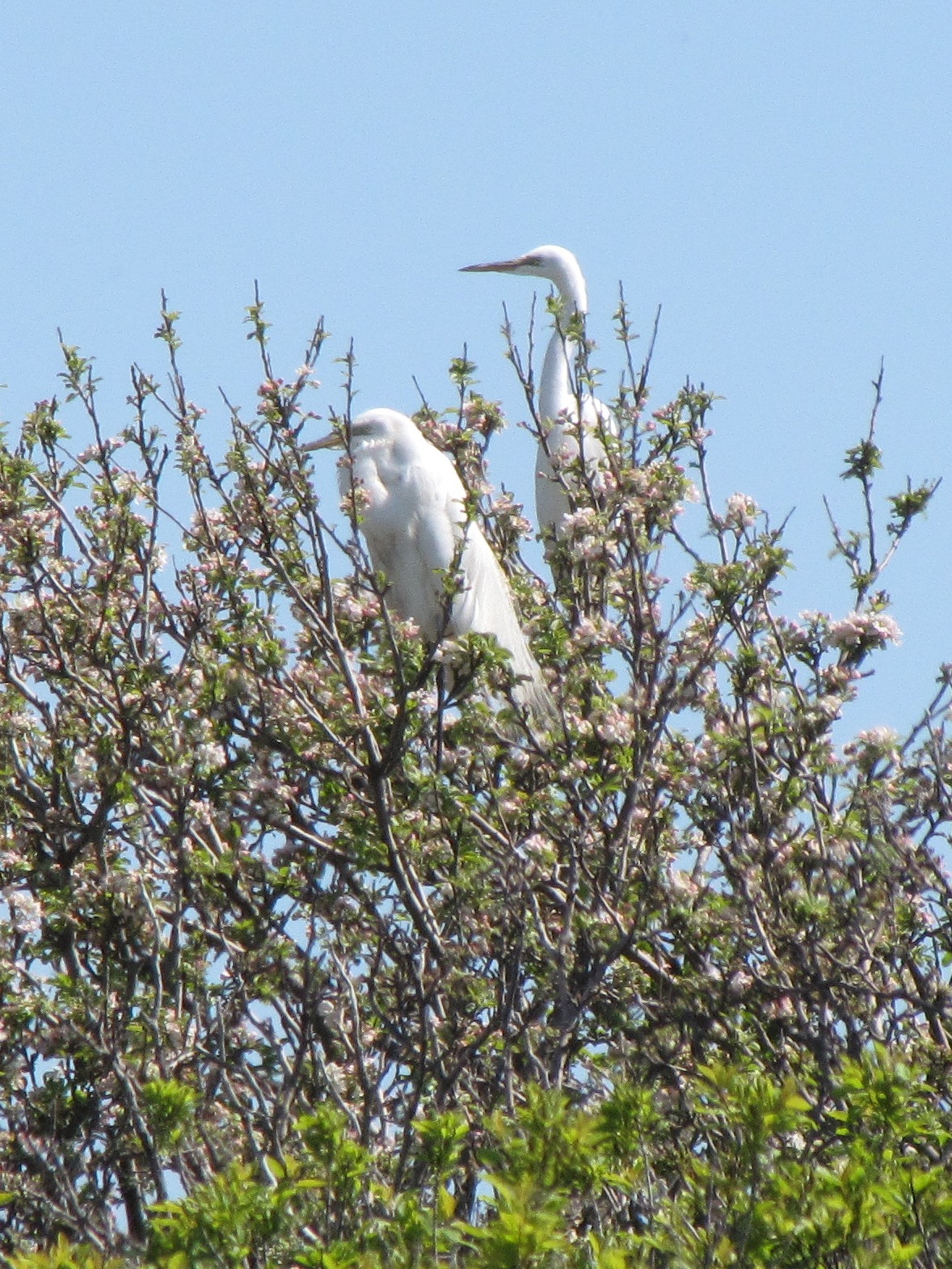 Snowy egrets perched in apple trees.[/caption]
This past May, I had the unique opportunity to assist National Audubon Society (NAS) with a wading bird census on Stratton Island in Saco Bay. Part of NAS’s Phineas W. Sprague Memorial Sanctuary, this 23-acre island is located 1.5 miles south of Prout’s Neck and is home to an immense diversity of wading birds, waterfowl, seabirds, and songbirds, and is an important stopover for all the above during migration.
In fact, Stratton Island hosts the most diverse wading bird colony in Maine, and is the most northerly U.S. breeding location for a few of these species. On the north side of the island, great and snowy egrets, black-crowned night-herons, little blue herons, and glossy ibis layer their nests in among the branches of choke cherry and apple trees.
[caption id="attachment_908" align="alignleft" width="300"]
Snowy egrets perched in apple trees.[/caption]
This past May, I had the unique opportunity to assist National Audubon Society (NAS) with a wading bird census on Stratton Island in Saco Bay. Part of NAS’s Phineas W. Sprague Memorial Sanctuary, this 23-acre island is located 1.5 miles south of Prout’s Neck and is home to an immense diversity of wading birds, waterfowl, seabirds, and songbirds, and is an important stopover for all the above during migration.
In fact, Stratton Island hosts the most diverse wading bird colony in Maine, and is the most northerly U.S. breeding location for a few of these species. On the north side of the island, great and snowy egrets, black-crowned night-herons, little blue herons, and glossy ibis layer their nests in among the branches of choke cherry and apple trees.
[caption id="attachment_908" align="alignleft" width="300"]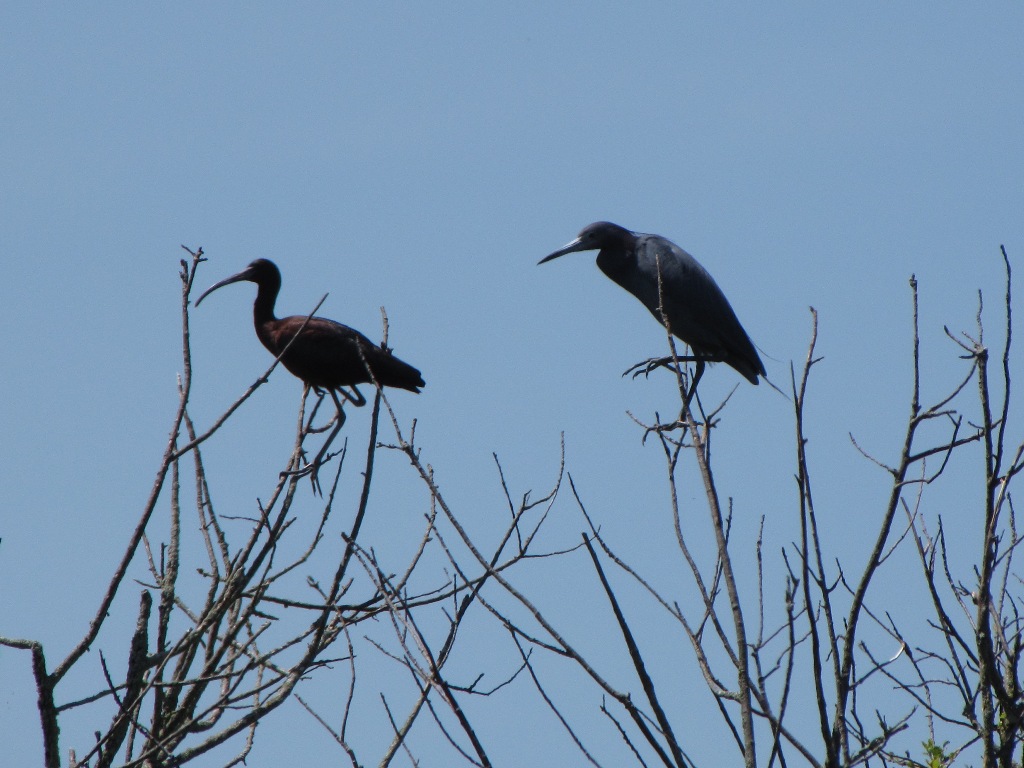 Glossy ibis and little blue heron.[/caption]
Despite this unique diversity of nesting wading birds, management and research efforts on the island primarily focus on the tern colony along the beaches. The wading bird colony is essentially a “no entry” area with the exception of a 3-4 day period in May when the nests are censused.
The census is always around the third week of May, and coincides with a period just prior to peak hatch. This timing maximizes the number of nests with a complete clutch of eggs and minimizes the number of sensitive nestlings that are disturbed. The census is conducted in the morning for a maximum of 2.5 hours. This prevents exposing eggs and newly hatched nestlings to the hot afternoon sun, and allows the disturbance to be contained to just a portion of the day enabling the adults to focus on provisioning their young the rest of the day.
[caption id="attachment_911" align="alignleft" width="300"]
Glossy ibis and little blue heron.[/caption]
Despite this unique diversity of nesting wading birds, management and research efforts on the island primarily focus on the tern colony along the beaches. The wading bird colony is essentially a “no entry” area with the exception of a 3-4 day period in May when the nests are censused.
The census is always around the third week of May, and coincides with a period just prior to peak hatch. This timing maximizes the number of nests with a complete clutch of eggs and minimizes the number of sensitive nestlings that are disturbed. The census is conducted in the morning for a maximum of 2.5 hours. This prevents exposing eggs and newly hatched nestlings to the hot afternoon sun, and allows the disturbance to be contained to just a portion of the day enabling the adults to focus on provisioning their young the rest of the day.
[caption id="attachment_911" align="alignleft" width="300"]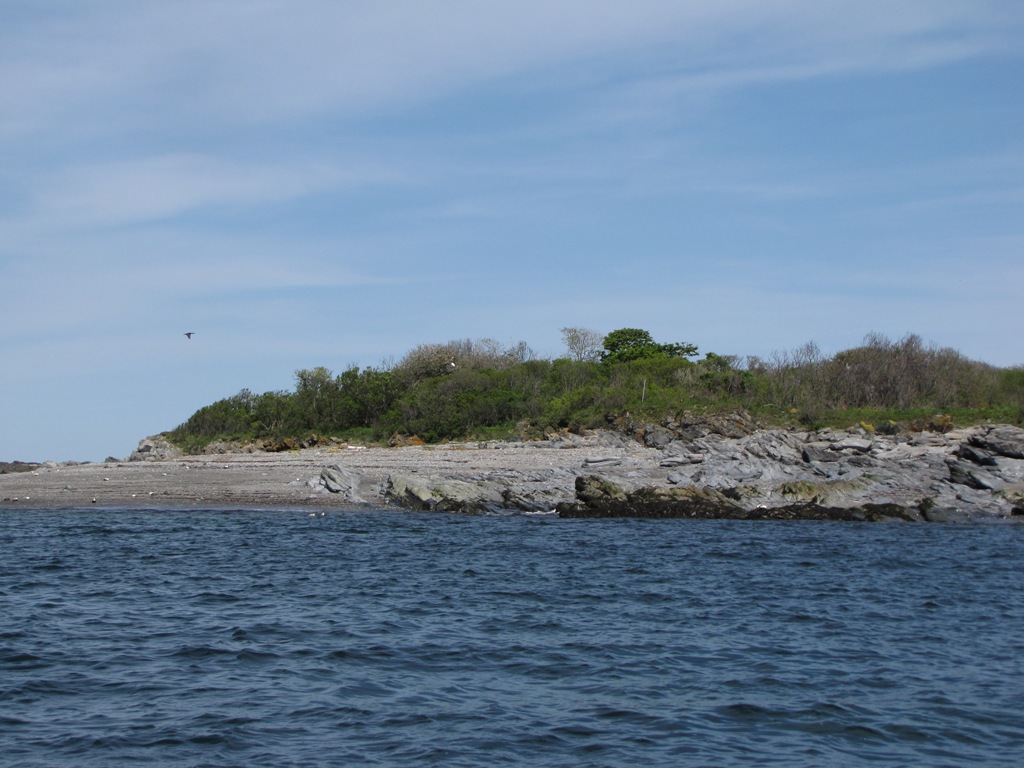 Stratton Island's wading bird colony, as seen from a boat.[/caption]
As we move through the colony, we locate nests, number them the metal tags, and identify them based on nest structure and contents. Many nests can be checked by simply peering over the nest edge, but a good portion are well above our heads and require a mirror pole (a pole with a mirror attached on one end) to see into them.
It is not easy work. The branches of the trees and shrubs are interwoven producing an almost impenetrable barrier between the observer and the nests. Not to mention the invasive bittersweet entangling many of the trees adds to the mess. The branches are all covered with guano (bird feces), which inevitably gets all over us. We also need to tiptoe around common eider nests that are well hidden in the ground cover of raspberry bushes or stinging nettles. The eiders usually flush before we get there, but I’d hate to step on those eggs they have worked so hard to protect from real predators (compared to us clumsy humans).
[caption id="attachment_914" align="alignleft" width="300"]
Stratton Island's wading bird colony, as seen from a boat.[/caption]
As we move through the colony, we locate nests, number them the metal tags, and identify them based on nest structure and contents. Many nests can be checked by simply peering over the nest edge, but a good portion are well above our heads and require a mirror pole (a pole with a mirror attached on one end) to see into them.
It is not easy work. The branches of the trees and shrubs are interwoven producing an almost impenetrable barrier between the observer and the nests. Not to mention the invasive bittersweet entangling many of the trees adds to the mess. The branches are all covered with guano (bird feces), which inevitably gets all over us. We also need to tiptoe around common eider nests that are well hidden in the ground cover of raspberry bushes or stinging nettles. The eiders usually flush before we get there, but I’d hate to step on those eggs they have worked so hard to protect from real predators (compared to us clumsy humans).
[caption id="attachment_914" align="alignleft" width="300"]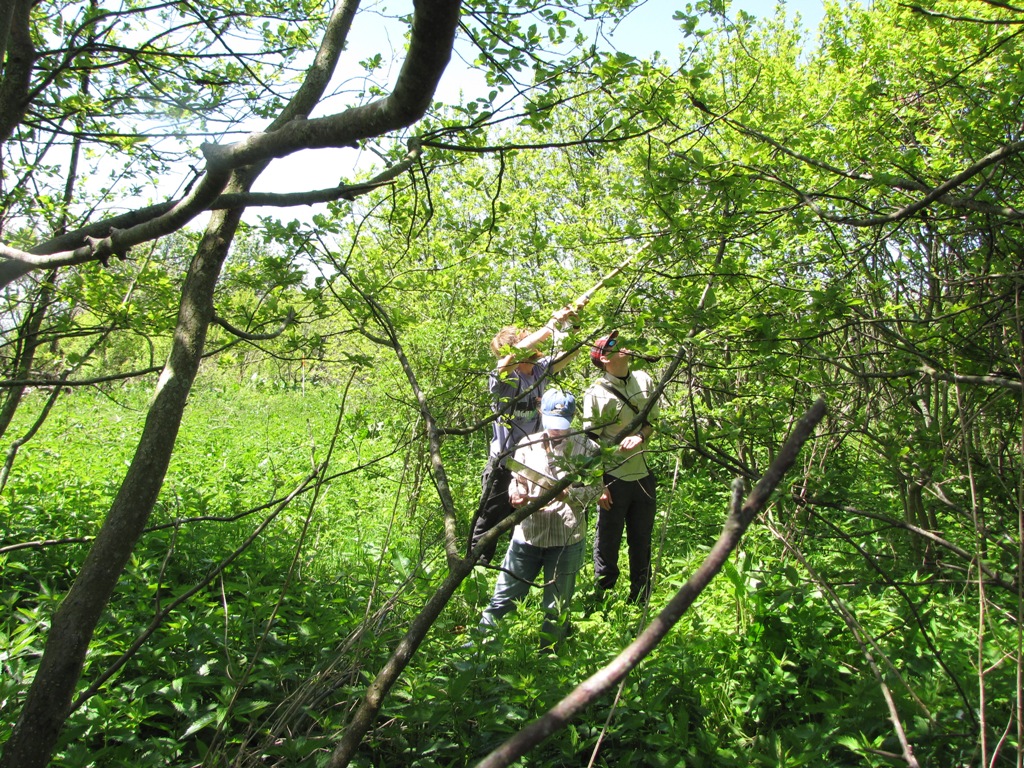 Surveyors using a mirror pole to see into a high nest.[/caption]
Once we do get a good view of a nest, we count the eggs and nestlings and decide on species. This is also not an easy task. They all have greenish-blue eggs that are elliptical or sub-elliptical in shape, and their nests are all made of sticks, twigs and sometimes finer material. So, how do we do it? It is a combination of egg size, shape and color, nestlings (if they are present), and the nesting materials. We do have one sophisticated tool for determining the eggs by species: a piece of cardboard with a hole in it! If an egg passes through it, it most likely does NOT belong to a black-crowned night-heron or a great egret. Then we go through a series of comparisons and essentially a process of elimination.
[caption id="attachment_917" align="alignleft" width="300"]
Surveyors using a mirror pole to see into a high nest.[/caption]
Once we do get a good view of a nest, we count the eggs and nestlings and decide on species. This is also not an easy task. They all have greenish-blue eggs that are elliptical or sub-elliptical in shape, and their nests are all made of sticks, twigs and sometimes finer material. So, how do we do it? It is a combination of egg size, shape and color, nestlings (if they are present), and the nesting materials. We do have one sophisticated tool for determining the eggs by species: a piece of cardboard with a hole in it! If an egg passes through it, it most likely does NOT belong to a black-crowned night-heron or a great egret. Then we go through a series of comparisons and essentially a process of elimination.
[caption id="attachment_917" align="alignleft" width="300"]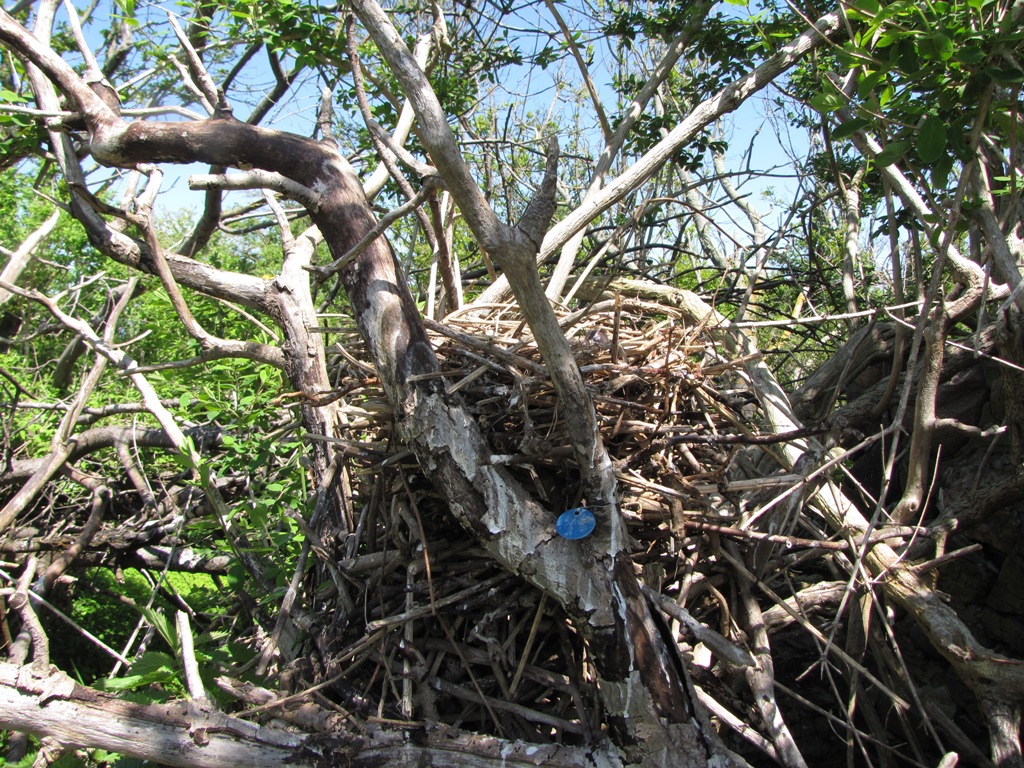 Nest in amongst the tree branch tangle.[/caption]
In the end, we can do fairly well EXCEPT for distinguishing snowy egret and little blue heron – their eggs are identical. A high count of adult little blue herons seen during the census is noted; half of that number is the likely minimum number of little blue heron nests that year.
I don’t know what this year’s final tallies were, but the yearly average is a total of 255 nests! For example, in 2009, 272 nests were counted:
Nest in amongst the tree branch tangle.[/caption]
In the end, we can do fairly well EXCEPT for distinguishing snowy egret and little blue heron – their eggs are identical. A high count of adult little blue herons seen during the census is noted; half of that number is the likely minimum number of little blue heron nests that year.
I don’t know what this year’s final tallies were, but the yearly average is a total of 255 nests! For example, in 2009, 272 nests were counted:
Below are additional photos of some nests, eggs, and nestlings. See if you can get the gist of what we are keying in on...
[caption id="attachment_920" align="aligncenter" width="500"]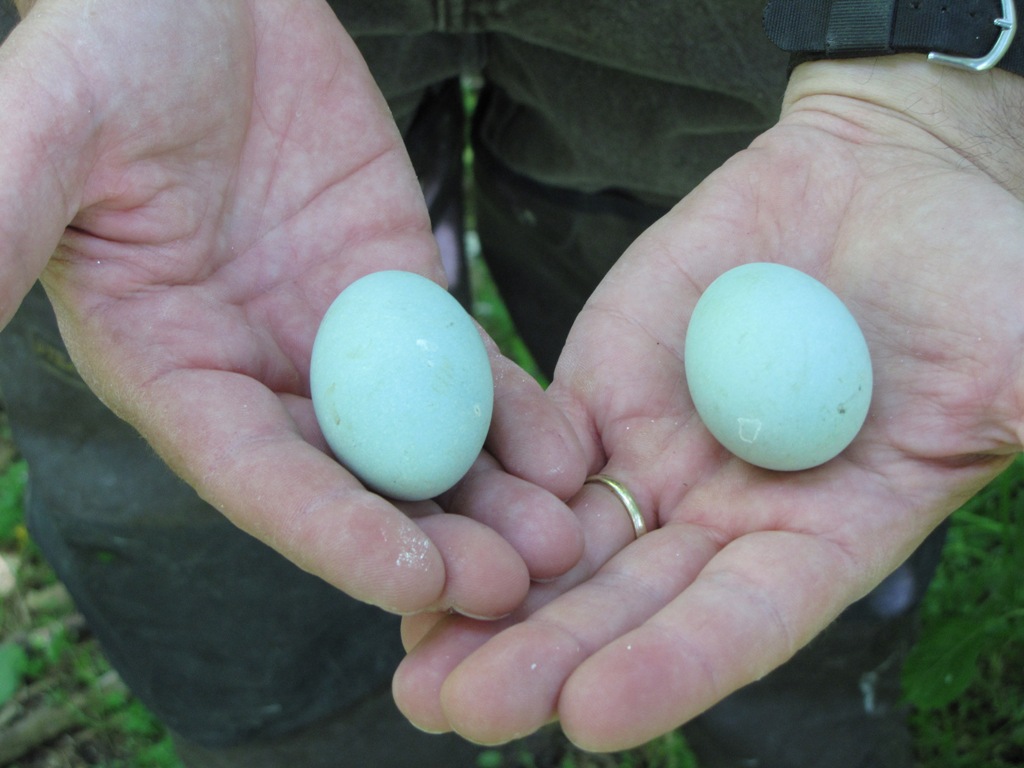 Comparing eggs: snowy egret on left and black-crowned night-heron on right (I think!).[/caption]
Comparing eggs: snowy egret on left and black-crowned night-heron on right (I think!).[/caption]
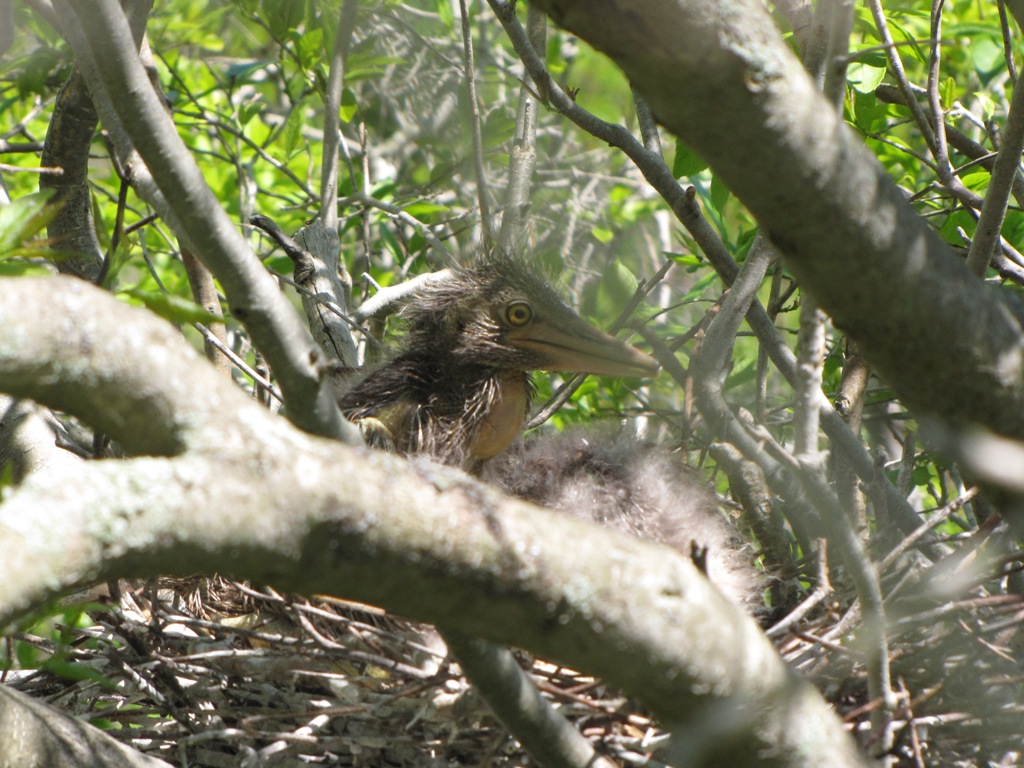 [caption id="attachment_929" align="aligncenter" width="500"]
[caption id="attachment_929" align="aligncenter" width="500"]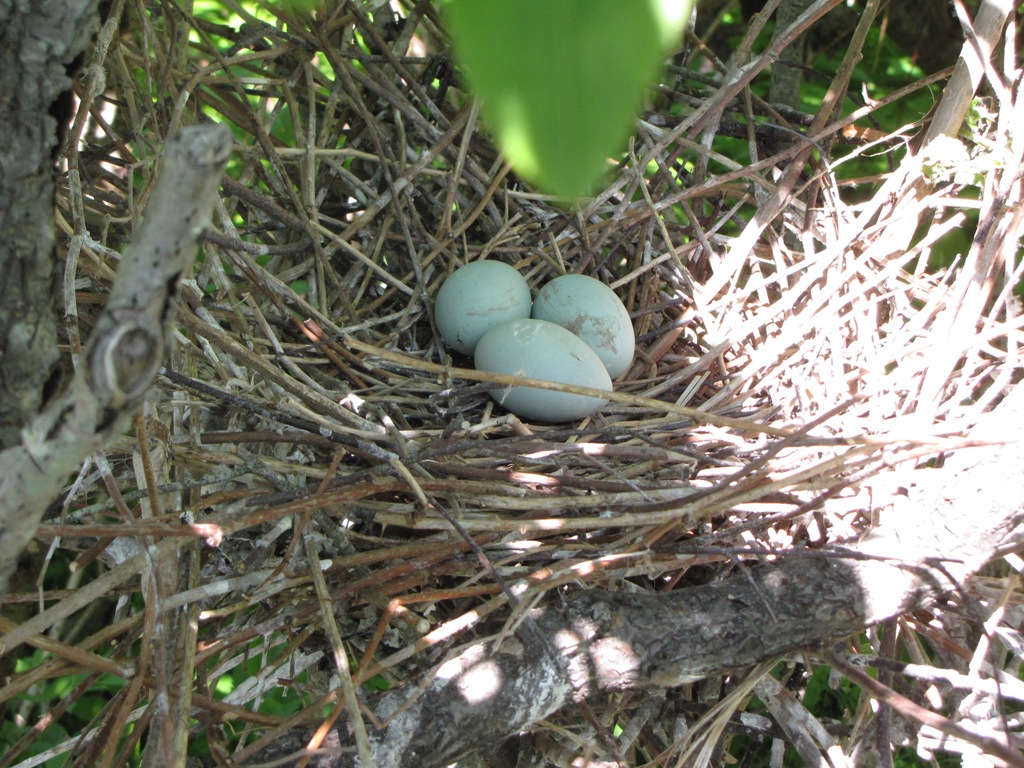 Black-crowned night-heron nest with eggs. Eggs are more “squat” than snowy and great egret eggs.[/caption]
[caption id="attachment_932" align="aligncenter" width="500"]
Black-crowned night-heron nest with eggs. Eggs are more “squat” than snowy and great egret eggs.[/caption]
[caption id="attachment_932" align="aligncenter" width="500"]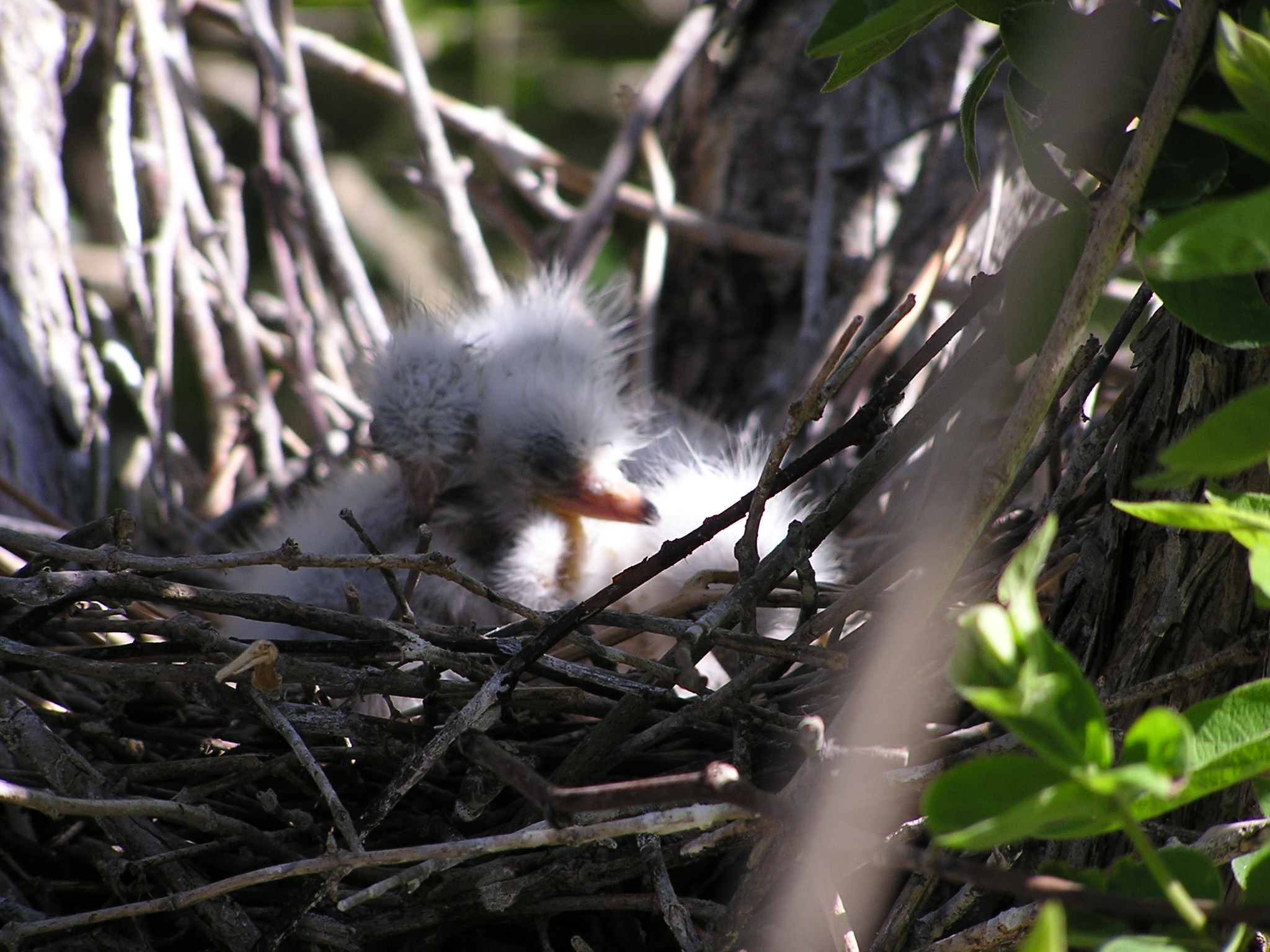 Snowy egret nestling. Photo by Robby Lambert.[/caption]
[caption id="attachment_938" align="aligncenter" width="500"]
Snowy egret nestling. Photo by Robby Lambert.[/caption]
[caption id="attachment_938" align="aligncenter" width="500"]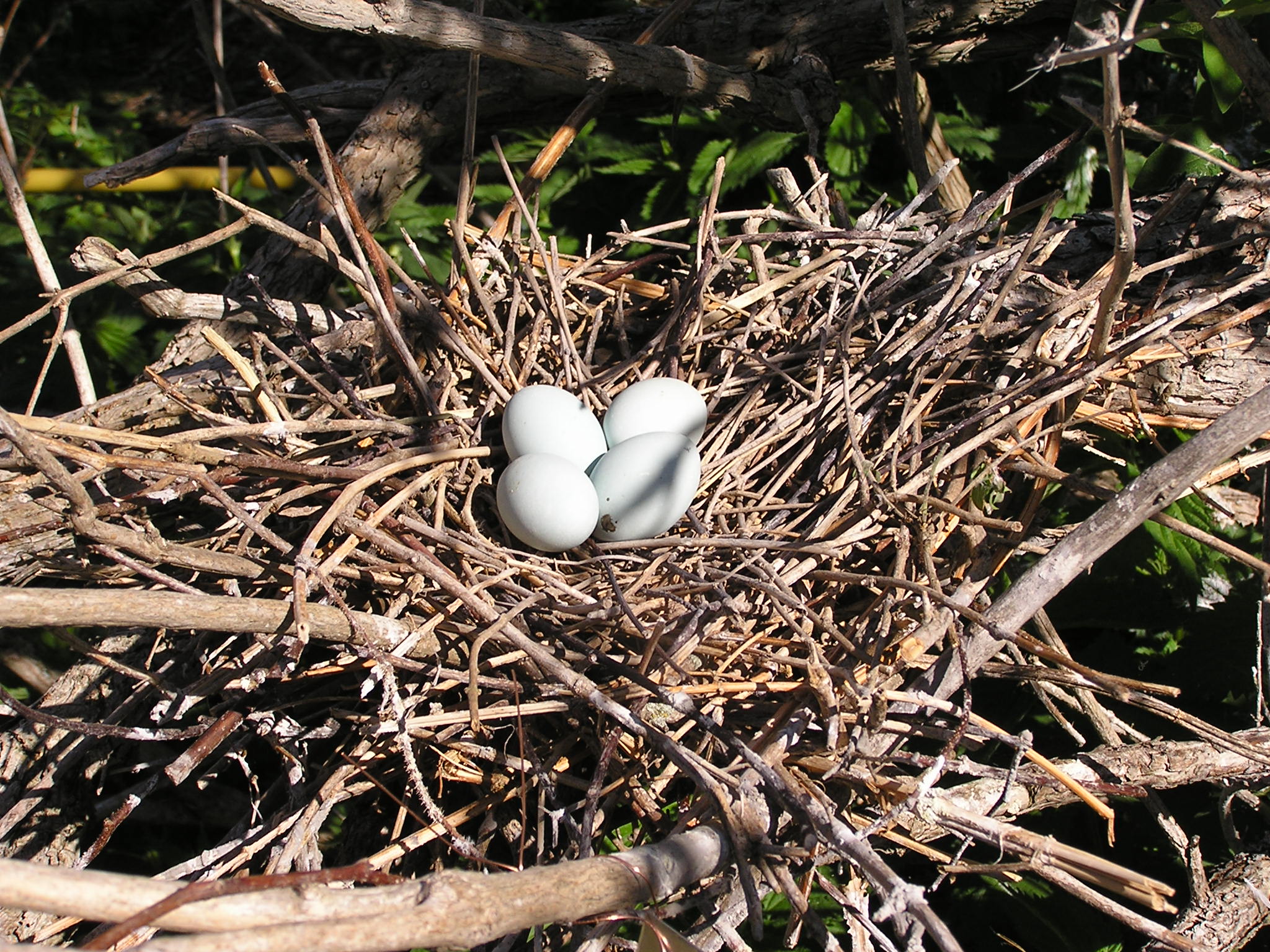 Snowy egret nest with eggs. Eggs are evenly oval. Great egret nests are also made of sticks, but generally are larger; eggs are slightly larger as well. These eggs look white due to direct sunlight, but they are really a greenish-blue. Photo by Robby Lambert.[/caption]
[caption id="attachment_941" align="aligncenter" width="500"]
Snowy egret nest with eggs. Eggs are evenly oval. Great egret nests are also made of sticks, but generally are larger; eggs are slightly larger as well. These eggs look white due to direct sunlight, but they are really a greenish-blue. Photo by Robby Lambert.[/caption]
[caption id="attachment_941" align="aligncenter" width="500"]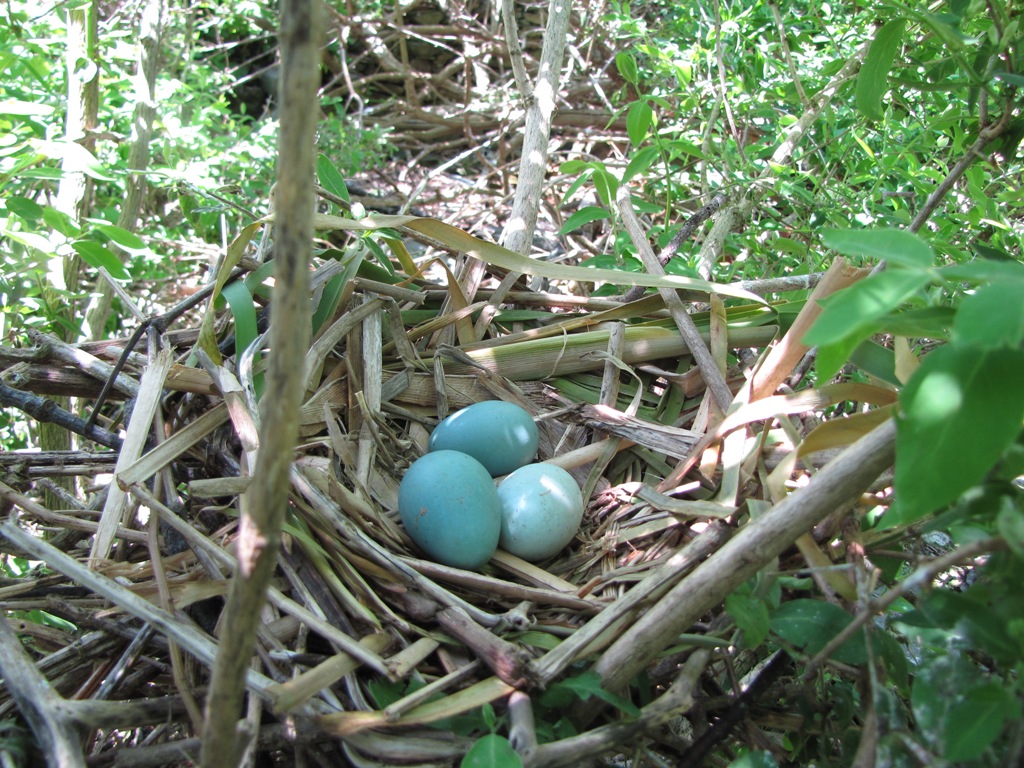 Glossy ibis nest with eggs. Egg on right is a bit atypical. Ibis eggs are a deeper blue and tend to be more teardrop shaped. Nest has more elaborate lining with finer materials than all the other wader nests.[/caption]
[caption id="attachment_944" align="aligncenter" width="500"]
Glossy ibis nest with eggs. Egg on right is a bit atypical. Ibis eggs are a deeper blue and tend to be more teardrop shaped. Nest has more elaborate lining with finer materials than all the other wader nests.[/caption]
[caption id="attachment_944" align="aligncenter" width="500"]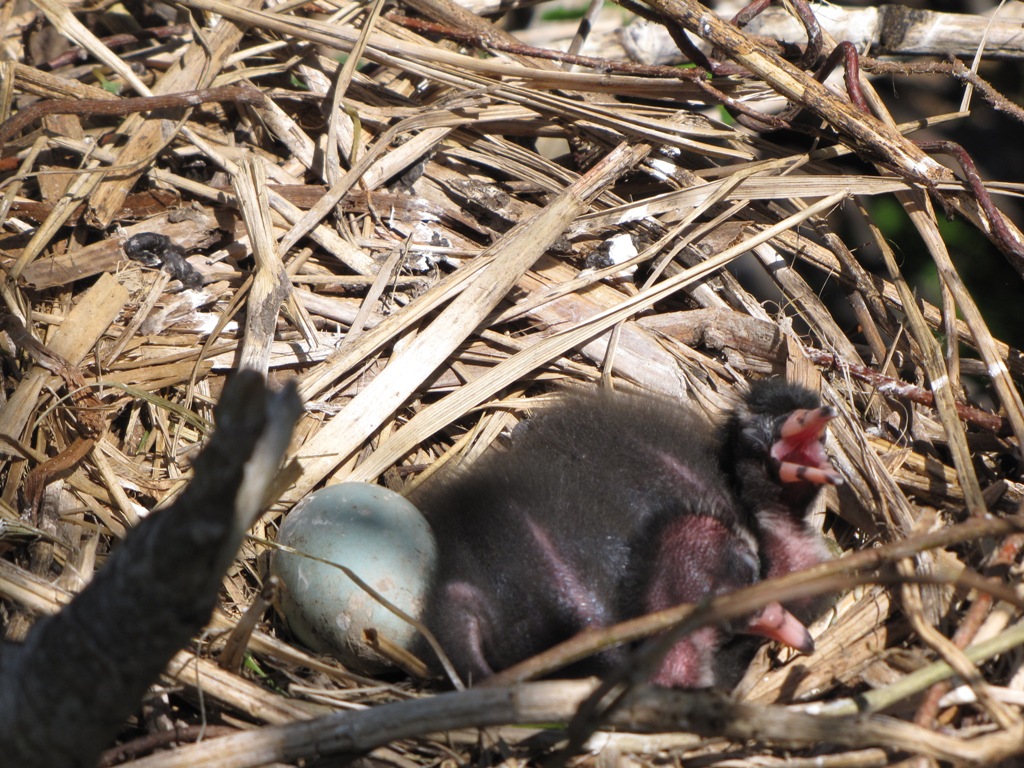 Glossy ibis nestlings and 1 unhatched egg. Note the dark feathers and pink bill with black stripes.[/caption]
[caption id="attachment_947" align="aligncenter" width="500"]
Glossy ibis nestlings and 1 unhatched egg. Note the dark feathers and pink bill with black stripes.[/caption]
[caption id="attachment_947" align="aligncenter" width="500"]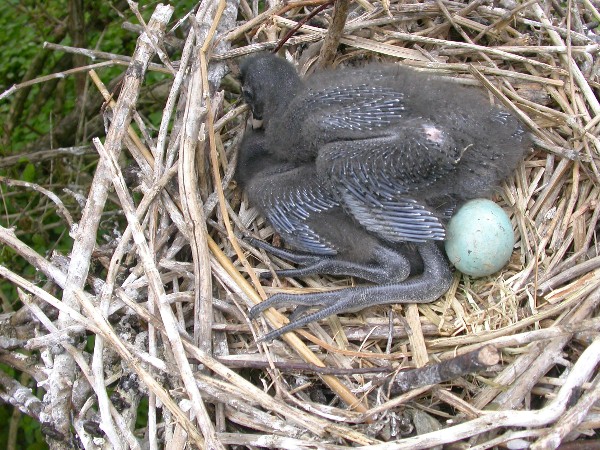 Glossy ibis nestlings and 1 unhatched egg. Photo by Robby Lambert.[/caption]
[caption id="attachment_950" align="aligncenter" width="500"]
Glossy ibis nestlings and 1 unhatched egg. Photo by Robby Lambert.[/caption]
[caption id="attachment_950" align="aligncenter" width="500"]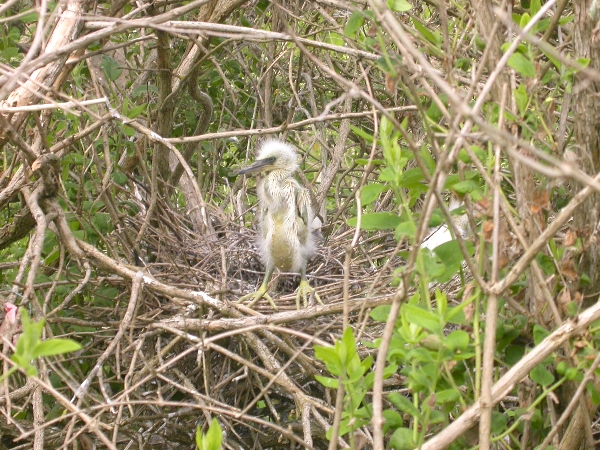 Great egret nestling. Photo by Robby Lambert.[/caption]
This work is supported by state revenues from the Loon Conservation Plate and Chickadee Checkoff Funds.
Great egret nestling. Photo by Robby Lambert.[/caption]
This work is supported by state revenues from the Loon Conservation Plate and Chickadee Checkoff Funds.
 Snowy egrets perched in apple trees.[/caption]
This past May, I had the unique opportunity to assist National Audubon Society (NAS) with a wading bird census on Stratton Island in Saco Bay. Part of NAS’s Phineas W. Sprague Memorial Sanctuary, this 23-acre island is located 1.5 miles south of Prout’s Neck and is home to an immense diversity of wading birds, waterfowl, seabirds, and songbirds, and is an important stopover for all the above during migration.
In fact, Stratton Island hosts the most diverse wading bird colony in Maine, and is the most northerly U.S. breeding location for a few of these species. On the north side of the island, great and snowy egrets, black-crowned night-herons, little blue herons, and glossy ibis layer their nests in among the branches of choke cherry and apple trees.
[caption id="attachment_908" align="alignleft" width="300"]
Snowy egrets perched in apple trees.[/caption]
This past May, I had the unique opportunity to assist National Audubon Society (NAS) with a wading bird census on Stratton Island in Saco Bay. Part of NAS’s Phineas W. Sprague Memorial Sanctuary, this 23-acre island is located 1.5 miles south of Prout’s Neck and is home to an immense diversity of wading birds, waterfowl, seabirds, and songbirds, and is an important stopover for all the above during migration.
In fact, Stratton Island hosts the most diverse wading bird colony in Maine, and is the most northerly U.S. breeding location for a few of these species. On the north side of the island, great and snowy egrets, black-crowned night-herons, little blue herons, and glossy ibis layer their nests in among the branches of choke cherry and apple trees.
[caption id="attachment_908" align="alignleft" width="300"] Glossy ibis and little blue heron.[/caption]
Despite this unique diversity of nesting wading birds, management and research efforts on the island primarily focus on the tern colony along the beaches. The wading bird colony is essentially a “no entry” area with the exception of a 3-4 day period in May when the nests are censused.
The census is always around the third week of May, and coincides with a period just prior to peak hatch. This timing maximizes the number of nests with a complete clutch of eggs and minimizes the number of sensitive nestlings that are disturbed. The census is conducted in the morning for a maximum of 2.5 hours. This prevents exposing eggs and newly hatched nestlings to the hot afternoon sun, and allows the disturbance to be contained to just a portion of the day enabling the adults to focus on provisioning their young the rest of the day.
[caption id="attachment_911" align="alignleft" width="300"]
Glossy ibis and little blue heron.[/caption]
Despite this unique diversity of nesting wading birds, management and research efforts on the island primarily focus on the tern colony along the beaches. The wading bird colony is essentially a “no entry” area with the exception of a 3-4 day period in May when the nests are censused.
The census is always around the third week of May, and coincides with a period just prior to peak hatch. This timing maximizes the number of nests with a complete clutch of eggs and minimizes the number of sensitive nestlings that are disturbed. The census is conducted in the morning for a maximum of 2.5 hours. This prevents exposing eggs and newly hatched nestlings to the hot afternoon sun, and allows the disturbance to be contained to just a portion of the day enabling the adults to focus on provisioning their young the rest of the day.
[caption id="attachment_911" align="alignleft" width="300"] Stratton Island's wading bird colony, as seen from a boat.[/caption]
As we move through the colony, we locate nests, number them the metal tags, and identify them based on nest structure and contents. Many nests can be checked by simply peering over the nest edge, but a good portion are well above our heads and require a mirror pole (a pole with a mirror attached on one end) to see into them.
It is not easy work. The branches of the trees and shrubs are interwoven producing an almost impenetrable barrier between the observer and the nests. Not to mention the invasive bittersweet entangling many of the trees adds to the mess. The branches are all covered with guano (bird feces), which inevitably gets all over us. We also need to tiptoe around common eider nests that are well hidden in the ground cover of raspberry bushes or stinging nettles. The eiders usually flush before we get there, but I’d hate to step on those eggs they have worked so hard to protect from real predators (compared to us clumsy humans).
[caption id="attachment_914" align="alignleft" width="300"]
Stratton Island's wading bird colony, as seen from a boat.[/caption]
As we move through the colony, we locate nests, number them the metal tags, and identify them based on nest structure and contents. Many nests can be checked by simply peering over the nest edge, but a good portion are well above our heads and require a mirror pole (a pole with a mirror attached on one end) to see into them.
It is not easy work. The branches of the trees and shrubs are interwoven producing an almost impenetrable barrier between the observer and the nests. Not to mention the invasive bittersweet entangling many of the trees adds to the mess. The branches are all covered with guano (bird feces), which inevitably gets all over us. We also need to tiptoe around common eider nests that are well hidden in the ground cover of raspberry bushes or stinging nettles. The eiders usually flush before we get there, but I’d hate to step on those eggs they have worked so hard to protect from real predators (compared to us clumsy humans).
[caption id="attachment_914" align="alignleft" width="300"] Surveyors using a mirror pole to see into a high nest.[/caption]
Once we do get a good view of a nest, we count the eggs and nestlings and decide on species. This is also not an easy task. They all have greenish-blue eggs that are elliptical or sub-elliptical in shape, and their nests are all made of sticks, twigs and sometimes finer material. So, how do we do it? It is a combination of egg size, shape and color, nestlings (if they are present), and the nesting materials. We do have one sophisticated tool for determining the eggs by species: a piece of cardboard with a hole in it! If an egg passes through it, it most likely does NOT belong to a black-crowned night-heron or a great egret. Then we go through a series of comparisons and essentially a process of elimination.
[caption id="attachment_917" align="alignleft" width="300"]
Surveyors using a mirror pole to see into a high nest.[/caption]
Once we do get a good view of a nest, we count the eggs and nestlings and decide on species. This is also not an easy task. They all have greenish-blue eggs that are elliptical or sub-elliptical in shape, and their nests are all made of sticks, twigs and sometimes finer material. So, how do we do it? It is a combination of egg size, shape and color, nestlings (if they are present), and the nesting materials. We do have one sophisticated tool for determining the eggs by species: a piece of cardboard with a hole in it! If an egg passes through it, it most likely does NOT belong to a black-crowned night-heron or a great egret. Then we go through a series of comparisons and essentially a process of elimination.
[caption id="attachment_917" align="alignleft" width="300"] Nest in amongst the tree branch tangle.[/caption]
In the end, we can do fairly well EXCEPT for distinguishing snowy egret and little blue heron – their eggs are identical. A high count of adult little blue herons seen during the census is noted; half of that number is the likely minimum number of little blue heron nests that year.
I don’t know what this year’s final tallies were, but the yearly average is a total of 255 nests! For example, in 2009, 272 nests were counted:
Nest in amongst the tree branch tangle.[/caption]
In the end, we can do fairly well EXCEPT for distinguishing snowy egret and little blue heron – their eggs are identical. A high count of adult little blue herons seen during the census is noted; half of that number is the likely minimum number of little blue heron nests that year.
I don’t know what this year’s final tallies were, but the yearly average is a total of 255 nests! For example, in 2009, 272 nests were counted:
| Species |
# Nests |
| Snowy egret |
132 |
| Glossy ibis |
100 |
| Black-crowned night-heron |
21 |
| Great egret |
19 |
| Little blue heron |
minimum # of pairs =2 |
 Comparing eggs: snowy egret on left and black-crowned night-heron on right (I think!).[/caption]
Comparing eggs: snowy egret on left and black-crowned night-heron on right (I think!).[/caption]
 [caption id="attachment_929" align="aligncenter" width="500"]
[caption id="attachment_929" align="aligncenter" width="500"] Black-crowned night-heron nest with eggs. Eggs are more “squat” than snowy and great egret eggs.[/caption]
[caption id="attachment_932" align="aligncenter" width="500"]
Black-crowned night-heron nest with eggs. Eggs are more “squat” than snowy and great egret eggs.[/caption]
[caption id="attachment_932" align="aligncenter" width="500"] Snowy egret nestling. Photo by Robby Lambert.[/caption]
[caption id="attachment_938" align="aligncenter" width="500"]
Snowy egret nestling. Photo by Robby Lambert.[/caption]
[caption id="attachment_938" align="aligncenter" width="500"] Snowy egret nest with eggs. Eggs are evenly oval. Great egret nests are also made of sticks, but generally are larger; eggs are slightly larger as well. These eggs look white due to direct sunlight, but they are really a greenish-blue. Photo by Robby Lambert.[/caption]
[caption id="attachment_941" align="aligncenter" width="500"]
Snowy egret nest with eggs. Eggs are evenly oval. Great egret nests are also made of sticks, but generally are larger; eggs are slightly larger as well. These eggs look white due to direct sunlight, but they are really a greenish-blue. Photo by Robby Lambert.[/caption]
[caption id="attachment_941" align="aligncenter" width="500"] Glossy ibis nest with eggs. Egg on right is a bit atypical. Ibis eggs are a deeper blue and tend to be more teardrop shaped. Nest has more elaborate lining with finer materials than all the other wader nests.[/caption]
[caption id="attachment_944" align="aligncenter" width="500"]
Glossy ibis nest with eggs. Egg on right is a bit atypical. Ibis eggs are a deeper blue and tend to be more teardrop shaped. Nest has more elaborate lining with finer materials than all the other wader nests.[/caption]
[caption id="attachment_944" align="aligncenter" width="500"] Glossy ibis nestlings and 1 unhatched egg. Note the dark feathers and pink bill with black stripes.[/caption]
[caption id="attachment_947" align="aligncenter" width="500"]
Glossy ibis nestlings and 1 unhatched egg. Note the dark feathers and pink bill with black stripes.[/caption]
[caption id="attachment_947" align="aligncenter" width="500"] Glossy ibis nestlings and 1 unhatched egg. Photo by Robby Lambert.[/caption]
[caption id="attachment_950" align="aligncenter" width="500"]
Glossy ibis nestlings and 1 unhatched egg. Photo by Robby Lambert.[/caption]
[caption id="attachment_950" align="aligncenter" width="500"] Great egret nestling. Photo by Robby Lambert.[/caption]
This work is supported by state revenues from the Loon Conservation Plate and Chickadee Checkoff Funds.
Great egret nestling. Photo by Robby Lambert.[/caption]
This work is supported by state revenues from the Loon Conservation Plate and Chickadee Checkoff Funds.Categories